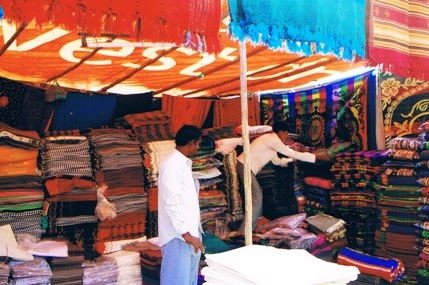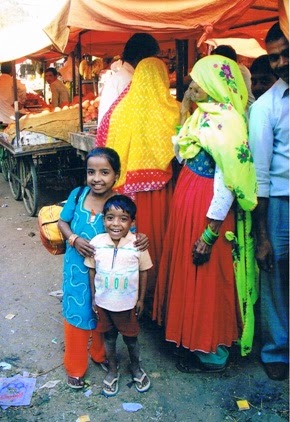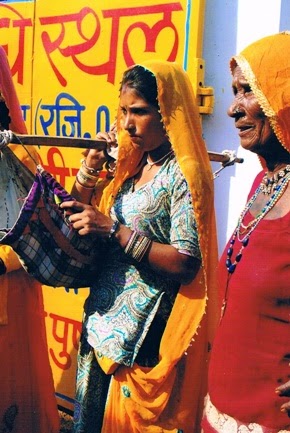Throngs of humanity move in waves of color -
saffron, cobalt, magenta. Dust and sand
rise in puffs around sandal-clad feet. A
cacophony of noise saturates the air - voices calling, animals braying. The pungent scent of exotic spices mingles
with the cloying odor of dung and wafts
over the crowd. Even in the quiet hours
before dawn and in the evening dusk, the air seems to pulsate with the fullness
of life.
 |
| A combination of dust and smoke from cooking fires creates a haze that hangs over the fields |
 |
| A group of men gather to visit and perhaps talk business |
 |
| With nearly 50,000 camels at the festival, men and animals share space |
For two weeks during the Hindu month of Kartik (the 8th lunar month of the
year, typically late October into November) the Pushkar "Mela" or
"Camel Festival" has taken place since the fourth century BC in the
desert some 145 kilometers (90 miles) southwest of Jaipur, India.
Traders arrive with over 50,000 camels to sell,
trade or barter. Along with the camels,
cattle, donkeys and the beautiful, rare Marwari horses are offered to the
highest bidder. The camels are cleaned
and adorned. Some are brightly painted
in elaborate designs. Others sport
bangles around their ankles that jingle cheerfully as their owners parade or
race them, with the victors commanding top prices.
 |
| Herders bringing their camels to the festival |
 |
| A decorated camel pulls a cart through the town |
 |
Camels are adorned with cloths and beads as well as being
shorn in intricate patterns or gaily painted |
 |
A Marwari colt. Notice how the ears grow in toward one another,
and almost touch |
 |
| A cart loaded with goods |
The village of Pushkar, a hamlet of 15,000, surges
to a makeshift city of 400,000. The
festivities sprawl over acres of desert
where traders, families, pilgrims and tourists all set up their encampments.
Impromptu food stalls and booths selling ethnic goods appear on the landscape. Musicians, dancers, even fire-eaters enliven
the campgrounds. Much is offered for
sale, but no eggs, meat or alcohol is allowed.
 |
| The normal population of 15,000 swells to the hundreds of thousands during the festival |
 |
| This stall is selling the beads and cloths used to adorn the camels |
 |
| While this one is selling cloth for human use |
 |
| Spices for sale in this shop |
 |
Children are the same around the world...they love to have their pictures taken.
I was careful to ask permission before I took any close-up photos of people |
 |
| Dancers performing...it is a festival, after all |
 |
| Dancers...and fire-eaters...what a spectacle |
 |
This group of dancers was waiting to perform for some government officials who were
coming to the festival, but the government officials were two hours late at this point |
Pushkar is, all at the same time, a place of
business, a festival and finally (and most importantly) a religious gathering. Pushkar is one of the five sacred dhams
(pilgrimages) that devout Hindus aspire to make in a lifetime. The only temple in India dedicated to Brahma, the
god of creation, is located here, near the shores of sacred Pushkar Lake. The village has over 400 temples and 52 "ghats". a series of steps leading down to a holy
river or other body of water. The most auspicious time to bath in the sacred
waters is the last night of the festival, which ends on the Kartik Purnima - the
night of the full moon of the eighth month of the lunar year. The commercialism gives way to the
spiritual, and the Pushkar festival culminates in a religious crescendo.
 |
I stayed in the first tent (closest to camera) in this row. It had a bed, dresser, shower
and flush toilet...that drained into an open ditch behind the row of tents. |
 |
A young boy tends camels. He already has gotten one to lay down, and with
his hand, he is motioning the other down to the ground |
 |
This picture might give you some perspective on just how many people crowd
into Pushkar for the festival. Camps and people as far as you can see. |
 |
| Another close-up of men and camels in very close quarters |
 |
| A woman and her tiny baby. |
 |
3 generations of Gypsies (the young woman has a baby in that sling on her right
shoulder.) The Gypsies were the only people who asked for money to take their photo. |
 |
I had a chance to fly over the festival in this hot air balloon. 2009, the
year I was there, was the first year the balloons were at the festival. |
 |
View of the festival grounds from the balloon. It was in this area that the
camel racing and trading as well as the dancing took place. |
"Pushkar" in Sanskrit means "blue lotus
flower". Hindus
believe that lotus petals were dropped by Brahma, the creator-god, and fell to
earth. The place where the lotus petals fell
became the sacred lakes of Pushkar - a place where I found interesting
people, incredible sights and fascinating Road
Stories.




























































